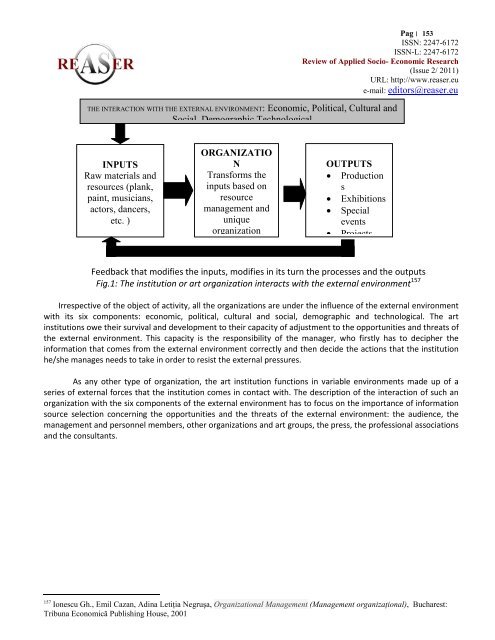Volume 2, ISSUE2/2011 - Review of Applied Socio-Economic ...
Volume 2, ISSUE2/2011 - Review of Applied Socio-Economic ...
Volume 2, ISSUE2/2011 - Review of Applied Socio-Economic ...
You also want an ePaper? Increase the reach of your titles
YUMPU automatically turns print PDFs into web optimized ePapers that Google loves.
Pag׀ 153 ISSN: 2247-6172ISSN-L: 2247-6172<strong>Review</strong> <strong>of</strong> <strong>Applied</strong> <strong>Socio</strong>- <strong>Economic</strong> Research(Issue 2/ <strong>2011</strong>)URL: http://www.reaser.eue-mail: editors@reaser.euTHE INTERACTION WITH THE EXTERNAL ENVIRONMENT: <strong>Economic</strong>, Political, Cultural andSocial, Demographic,TechnologicalINPUTSRaw materials andresources (plank,paint, musicians,actors, dancers,etc. )ORGANIZATIONTransforms theinputs based onresourcemanagement anduniqueorganizationOUTPUTS• Productions• Exhibitions• Specialevents• ProjectsFeedback that modifies the inputs, modifies in its turn the processes and the outputsFig.1: The institution or art organization interacts with the external environment 157Irrespective <strong>of</strong> the object <strong>of</strong> activity, all the organizations are under the influence <strong>of</strong> the external environmentwith its six components: economic, political, cultural and social, demographic and technological. The artinstitutions owe their survival and development to their capacity <strong>of</strong> adjustment to the opportunities and threats <strong>of</strong>the external environment. This capacity is the responsibility <strong>of</strong> the manager, who firstly has to decipher theinformation that comes from the external environment correctly and then decide the actions that the institutionhe/she manages needs to take in order to resist the external pressures.As any other type <strong>of</strong> organization, the art institution functions in variable environments made up <strong>of</strong> aseries <strong>of</strong> external forces that the institution comes in contact with. The description <strong>of</strong> the interaction <strong>of</strong> such anorganization with the six components <strong>of</strong> the external environment has to focus on the importance <strong>of</strong> informationsource selection concerning the opportunities and the threats <strong>of</strong> the external environment: the audience, themanagement and personnel members, other organizations and art groups, the press, the pr<strong>of</strong>essional associationsand the consultants.157Ionescu Gh., Emil Cazan, Adina LetiŃia Negruşa, Organizational Management (Management organizaŃional), Bucharest:Tribuna <strong>Economic</strong>ă Publishing House, 2001








